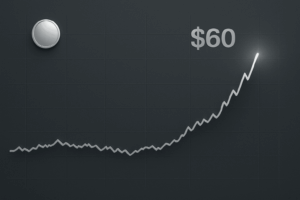U.S. households are now holding 80% of their wealth in equities — an all-time record. That’s higher than the 2021 peak, and even above the heights of the dot-com bubble.
On paper, it sounds like investors have faith in America’s future. But beneath the surface, it’s a dangerous concentration few recognize.
Even those who think they’re “balanced” with a 20% bond allocation aren’t getting the safety they expect. The correlation between stocks and bonds? 99%. That means both move together — up in good times, down in bad.
So, in real terms, most investors today are effectively 100% in stocks. They just don’t realize it yet.
The Data No One’s Talking About
Alan Hibbard breaks it down simply: U.S. household wealth has never been more tied to the S&P 500. And when a single asset class dominates your financial life, even small cracks can have devastating consequences.
History shows how fragile “paper wealth” can be. After the 2000 dot-com crash, the NASDAQ fell 78% and took 15 years to recover. The Great Depression? An 89% plunge that took 25 years to make new highs.
But here’s the problem: recent market rebounds have conditioned investors to expect instant recoveries — six months after COVID, 18 months after 2022, and just six weeks after 2025’s mini-correction.
As Alan warns, “The market is training you to believe every dip will bounce — until the one comes that doesn’t.” And when that happens, you might not live to see the recovery.
Stocks vs. Gold: Which One’s the “Poser”?
At first glance, both stocks and gold are hitting all-time highs. But Alan poses the uncomfortable question: Which one is real, and which one is an illusion?
When adjusted for inflation — or for gold — the picture changes dramatically. Gold has outperformed the NASDAQ over the past five years, gaining 112% versus the NASDAQ’s 98%. Silver has done even better, soaring 177%.
So while paper valuations look impressive, the “real” store of value — measured in ounces, not dollars — tells a different story.
As Alan puts it, “One of them is sincerely making real all-time highs. The other is mostly an illusion.”
The CAPE Ratio and the Next Big Bubble
To understand how stretched markets have become, Alan looks at the CAPE ratio — the cyclically adjusted price-to-earnings ratio tracked by economist Robert Shiller.
Historically, the CAPE ratio has exceeded 40 only during moments of extreme speculation: the late 1920s, the dot-com bubble, and now — September 2025.
When valuations reach this level, future returns tend to collapse. Every prior peak was followed by a decade or more of underperformance.
Combine this with political pressure on the Federal Reserve and record government debt, and the parallels to the late 1990s — or even the 1970s — are hard to ignore.
The writing is on the wall: we are likely living through another equity bubble in disguise.
The Dow/Gold Ratio: The Signal Few Investors Watch
If you really want to understand long-term value, Alan says, you have to measure stocks in ounces of gold — not dollars.
This is where the Dow/Gold ratio comes in. It tells you how many ounces of gold it takes to “buy” the Dow Jones Industrial Average.
In 1999, that number was 44. Today, it’s down around 12 — and falling. Historically, each time the ratio has peaked, it’s taken decades to recover.
- After 1929: 30 years to recover in gold terms
- After 1966: 32 years
- After 1999: still not recovered — and likely won’t for another 20+ years
The takeaway? You could be holding “wealth” that looks stable in dollar terms but is actually losing value in real, tangible terms.
Gold’s Quiet Strength in a Fragile System
In times like these — when both stocks and bonds are moving in lockstep, and valuations are stretched beyond reason — gold and silver offer something rare: independence.
They don’t rely on central bank credibility or Wall Street optimism. They simply are.
As Alan puts it, “You can’t sit in one asset class for your entire investing journey. You have to look at how one asset compares to another — and make sure you’re on the right side of the long-term cycle.”
For him, that means owning gold and silver. For others, it means asking hard questions about what’s real value — and what’s just paper promises.
Time to Rethink “Diversification”
The “80% problem” isn’t just a statistic. It’s a warning — one that history has given us many times before.
When everyone’s on one side of the boat, it only takes one wave to capsize it.
If your portfolio leans heavily on stocks, this is the moment to step back, rethink diversification, and consider the assets that have endured every cycle for over 5,000 years.
People Also Ask
Why is 80% of U.S. household wealth in stocks a problem?
When 80% of household wealth is tied to equities, portfolios become dangerously exposed to a single asset class. Even investors who hold bonds aren’t truly diversified — stock–bond correlations are now about 99%. Alan Hibbard explains why this concentration could spell trouble in his video, The 80% Red Alert for Stocks vs. Gold & Silver.
Are stocks and bonds still good diversifiers for each other?
Not anymore. In today’s environment, stocks and bonds move almost in lockstep, meaning traditional “balanced” portfolios don’t offer real protection. That’s why investors are looking to gold and silver as independent, non-correlated assets.
Has gold really outperformed the stock market recently?
Yes. Over the past five years, gold is up about 112%, outperforming the NASDAQ’s 98%, while silver surged roughly 177% in the same period. Hibbard breaks down why these metals are quietly leading even as stocks hit record highs.
What does the CAPE ratio say about today’s stock market?
The CAPE (cyclically adjusted price-to-earnings) ratio has reached levels seen only during major bubbles — the late 1920s, 1999, and now 2025. Historically, such readings signal overvaluation and weak long-term returns ahead.
What is the Dow/Gold ratio and why does it matter?
The Dow/Gold ratio measures how many ounces of gold it takes to “buy” the Dow Jones Industrial Average — a key indicator of real, inflation-adjusted value. When the ratio falls, gold is outperforming stocks; when it rises, stocks lead.
Get Gold & Silver Insights Direct to Your Inbox
Join thousands of smart investors who receive expert analysis, market updates, and exclusive deals every week.








